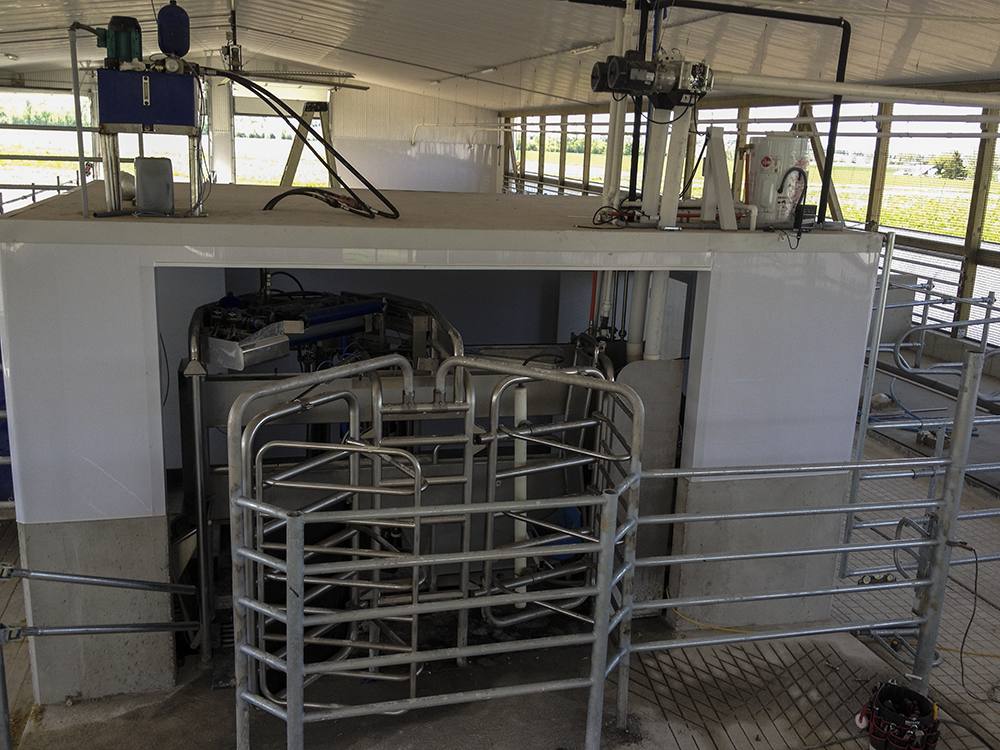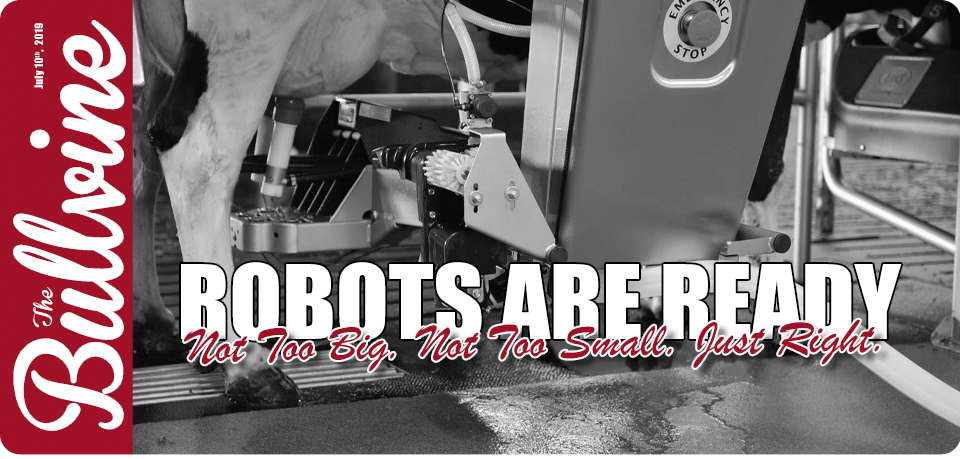
This opening quote may not include the modern technology that you now take for granted, but the point is that not so long ago, automation had not yet made it to the farm. However, as each new invention came along, it prompted new ways of working. Then, as a result, specialization of animal genetics and crop production started to evolve. The chain from farm gate to consumer also expanded. It quickly grew to include refrigerated transportation, advanced processing plants, focused milk marketing and giant retail grocery chains. Even as this was happening, those moving off the farm began to romanticize, “the way it was.”.
“Big or Small … Food Production is the Goal”
Everyone chimes in on what size farms should be. Sometimes it is a contentious issue. Having even a distant connection to the farm tends to make us want the small, gentle and familiar ways to remain. But that is unrealistic. The only real goal is that there must be enough healthy food for the consumer. The UN estimates that the world population will rise to 9.7 billion in the next thirty years. Old ways aren’t fast enough, big enough or safe enough to meet those needs. One of the noticeable differences is that we are going to lose the heritage farm scenes that fed small numbers. But that doesn’t mean that modern farmers are going to stop putting generations of homespun passion into dairy production. The systems must change. Evolving with the times has always been part of dairy farming history, but human farmers and dairy cattle are still the driving forces behind milk production even as it responds to the necessity of going high tech.
“Here Come the Robots!”
Technology is in our cars, our schools and our churches. In our lifetimes, everyone reading this article has witnessed science fiction technology move from books and movies and into our everyday life. Robots in the house clean carpets and floors and manage heat, lights and appliances. We have smartphones in our hands wherever we go. Robots are on the farm, increasing production yields. Drones are overhead. Tractors are managed by remote control. Robotic arms are in the milking parlor. Innovative applications are being created and are quickly evolving as new ideas propel new inventions, and the old ones become obsolete.
“It’s Your Turn. Turn to Robots. Turn A Profit”.
Using economies of scale, large dairy farms are turning to robots. In 2017 Whitney Davis writing for Dairy Business News wrote, “At present, there are approximately 40 herds of over 500 cows or more in North America now using robots.” Just one year later Doug Reinemann reported in Wisconsin Farmer that “the latest statistics indicate that a total of more than 200 dairy farms in Wisconsin and Minnesota and more than 300 in the United States, and upwards of 500 in Canada are equipped with robot milking units.” This is exciting news, and from my des, I found myself asking the question, “Faced with closing their doors, what is stopping the smaller dairy herd from using robots?” The answer is a game changer. First, answer money. And if you don’t have it in your current milk situation, how could you even think of going to robots? Many desk-dream ideas come to mind. Milk fewer cows. Get higher production. Convince financial and herd consultants to find the most profitable way to introduce robots to your herd. Robots are leading the way to the future. Financial support, rules and regulations and all the details that make this change feel like running-in-cement, make it not feasible for the dairy farm that is already bogged down.
Larry Tranel at IOWA STATE UNIVERSITY Extension and Outreach is a great resource for up-to-date information on Milking Robots. There you can expand on the following points.
What’s UP with Robots?
- Reliability, consistency and efficiency.
- Volumes of herd management and analysis information (100 measurements/milking).
- Cows eat more meals.
- Higher production per cow (from 10% to 30%).
- Pregnancy Rates go up.
- Milk quality payments go up because of reduced Somatic Cell Count.
- Cow longevity increases.
- Return on Investment.
- Cows thrive on consistency and predictability.
What’s Down with Robots?
- Total Milking Labour – 75% decrease.
- Hours spent on Heat Detection – 70% decrease.
- Hiring, training, and overseeing employees – decreased 37 minutes per day.
- Labour savings valued at $44,030 per year.
- Lameness is decreased.
- Cows are down …. They are resting more.
- Less Illness.
Adding up all these positives that are potentially available, it is more than worth the effort to find the way to make robotic milking possible. No robot can find the most workable solution for your situation. But you can. Everyone on the dairy team has to be open to all “what if” scenarios. Of course, turning to robots involves risk. And yes, doing nothing is definite. Definite failure.
“Change the Dairy Tale”
Everyone loves a good story. Dairy farmers often regale friends and family with their passion for the dairy lifestyle. Lifestyle is great, but it costs money. And then there’s the other side of the story. Too often, dairy consumers are telling the tale about factory farms taking over America’s pastured past. In 2019 we need to move beyond Old McDonald’s farm. Today’s fairy tale is more relatable to those ones where the wolf is at the door. We need to think of the clever turnabout where Red Riding Robot saves the day! Wouldn’t it be ironic if all the technology that got us to this dangerous precipice turns from villain to hero by saving the dairy industry? It isn’t technology that is to blame for where we are. It is whether we use it effectively or not. A story won’t make or break your dairy operation. The story of what you do will. Kids in our public schools are making APPS. Some are constructing 3D printers. If children can rewrite the story. So can dairy farmers. Not too big. Not too small. Just right.
“Don’t Fight Change. Fight for the Future”
So you’re not a factory farm. You don’t milk 500 cows. What is your niche? You need one. Whatever you do best, you need to make that your place in the dairy industry. Can you and a neighbour join forces the way corporations do to make your dairy production viable? By harnessing the strengths of two smaller but convenient (to each other) operations, perhaps you can produce more efficiently to a specific demand of your local processor or local consumers, as Bullvine author Murray Hunt wrote in, “Specialty Milk EQUALS Money Everyday”.
“Robots Beyond the Farm Gate”
While we are growing accustomed to robots working beside us on the farm, we need to encourage the same creativity and invention beyond the farm gate. For instance, warehousing and shipping are two places that also need to evolve. Most often, these areas trend toward larger is better. We need to creatively seek ways to ship our dairy products in more specialized and smaller, faster more accessible ways. Small shipments could mean more specialization and also that dairy aisles don’t have those empty shelves that are part of the empty pockets of milk producers at the front lines of milk production. We are not being loud enough in demanding research that improves the ways we get our product to our customers. Huge savings in manpower are needed in the processing and delivery of milk products. If dairy farms are robot ready and the linking dairy service industries are not, it is literally counterproductive for everybody.
The Bullvine Bottom Line
There is always the option of doing things the way they have always been done. Unfortunately, profits aren’t showing up with that same repetitive frequency. It’s time for dairy producers to open their gates, minds and dairies to change. Whether it’s mechanization or clever partnerships with neighbours, or creative financing or robotics, those who understand and want to remain in the modern dairy economy must eagerly find workable solutions to labour and production issues. Regardless of size, those dairies who are ready to change and evolve are the dairies that will remain and prosper.
Get original “Bullvine” content sent straight to your email inbox for free.

















